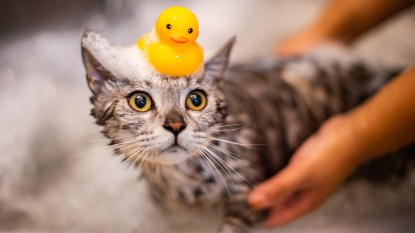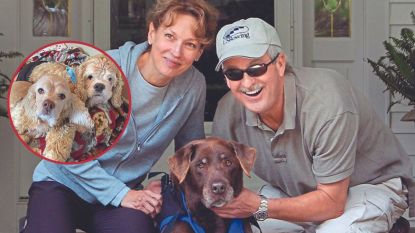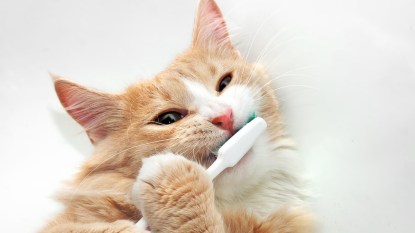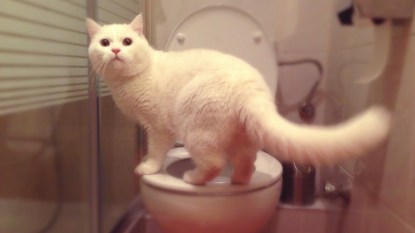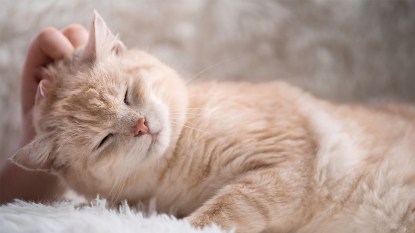Is My Dog Really Dreaming? Experts Answer This Burning Question
Is your dog drifting off to Dreamland?
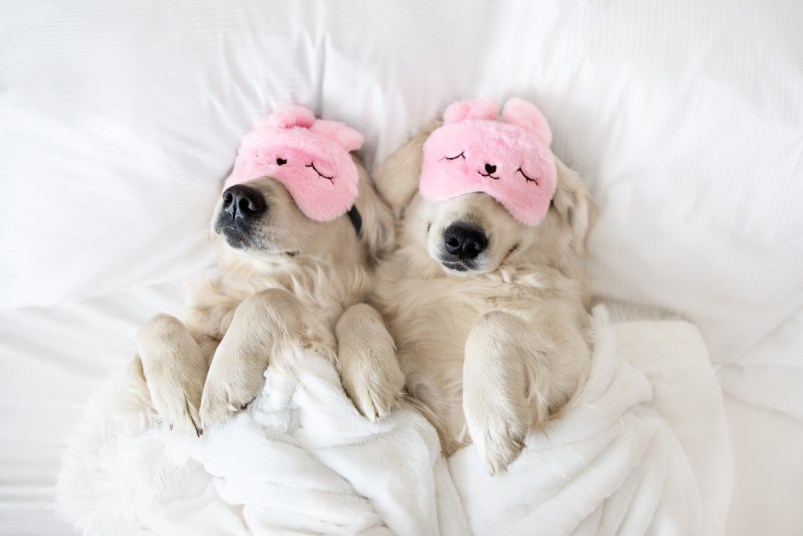
Recently, as my husband and I relaxed in front of the TV, I suddenly grabbed his arm and gestured to our lab mix, Rio, who was sprawled out on his bed, fast asleep. His tail was thumping up and down. “He’s ‘sleep wagging!’” I whispered, while we grinned at each other. I love watching Rio wag his tail while he’s sleeping because he must be feeling happy, even if he’s unconscious. I’ve always assumed he’s dreaming and wonder what he’s dreaming about. In this instance, we had just returned from a weekend camping trip. Was our dog dreaming about a hike, or swimming in the lake? Maybe he was thinking about a friendly dog he met on the trails, or snuggling in the tent.
Rio has always been an active sleeper. Sometimes he twitches, with his paws motoring back and forth in what we’ve dubbed “chasing bunnies.” Other times, he’ll let out a growl or a little woof. Is he playfully defending the yard from a squirrel in his dream? Or is he having a nightmare? Could he be recalling the dog who jumped out of the window of a parked car and attacked him? Then there’s the core question: Is my dog actually dreaming, or is it all in my head?
Do Dogs Dream? Here’s the Science Behind It
The answer is yes, according to Matthew Wilson, a neurobiology professor at Massachusetts Institute of Technology’s Picower Institute for Learning and Memory. Wilson’s groundbreaking scientific research found that rats dream and replay memories, which has implications for dogs and other mammals with the same brain structures. “The question of whether animals dream is complicated by the fact that we can’t get them to tell us what they were dreaming about,” he says. “So we need some way of actually directly interrogating the brain and saying, ‘Is the brain — during sleep — also processing information about experiences they’ve had, things they’ve seen, things that they’ve done?’”
The research team inserted electrodes into the rats’ brains and recorded the patterns of brain activity that occurred in the hippocampus — the part of the brain that captures information about our experiences — while the animals were awake. “It’s sort of like recording a movie of the experience,” notes Wilson. Then, when the animals went to sleep, the researchers monitored their brains to see whether the patterns occurred again.
“We can record in areas like the visual cortex and see the patterns that correspond with what they see,” Wilson explains. “And what we find is, during sleep, those patterns reoccur. We see the same patterns and the patterns in the same sequence as though the animal is moving through the world and seeing the images that were associated with that. That’s as close as we can get to identifying what animals might be experiencing during sleep — what we would call dreams. So we can say the animals experience these things as well.”
REM Sleep vs. Non-REM Sleep
Wilson finds it interesting that animals — in particular, mammals such as rats and dogs — have the same kind of sleep that humans do. It can be broken into two different stages: rapid eye movement (REM) sleep, and non-rapid eye movement sleep. REM sleep, also called paradoxical sleep, is the stage in which brain activity generally looks like the brain is awake; people wakened from REM sleep report having dreams. Wilson and his colleagues found brain activity in the rats during REM sleep corresponded to their experiences, such as navigating a maze.
“It’s as though the animal is actually running or actually moving through space, having these experiences,” he says. “That relates to what people might think of when they’re watching their dog. Your dog’s asleep, and you suddenly see these periods where their paws might start to move, and you hear their half-vocalizations. And you think, ‘Oh! They must be dreaming about chasing squirrels or running around.’ That would be these periods of REM sleep, where the dream content also includes movement.”
The Reward for Rest: Why Dogs Need Quality Sleep
There are important reasons to care about why dogs and other animals, including humans, have dreams, according to Wilson. For starters, a great deal of research suggests that memory processing during sleep or dreaming performs some critical functions and is what the brain uses to make sense of the world. “Sleep is designed to try to make sense of complicated things,” he says.
One critical way this impacts dogs is social interactions. When training a dog to “sit” or “come” when cued, we might say the word and use a hand signal, then click a clicker or say “yes!” while offering a treat or praise as a reward. But dreaming helps the learning go beyond rote repetition and into understanding the relationship we want to have with them, he explains. “You’re trying to teach them to be a good social companion that doesn’t jump up on you or your friends or doesn’t run ahead of you when you’re walking. That’s what they’re trying to figure out,” he says. “And that’s where sleep contributes, I think, in a unique way.”
Allowing our dogs to have quality, uninterrupted sleep is a key component of helping them grasp big-picture concepts. “In studying animals, we see that they have dreams and they do have value in learning. If you disrupt sleep, or you disrupt the dream content in sleep, you can selectively interfere with effective learning,” Wilson notes.
Impact of Sound: Why Dogs Need Peace and Quiet
Experiments have also shown playing sounds during sleep can influence dream content — something unsurprising to humans who have had our environment affect our dreams. “If you’re cold, your dreams might be about floating away on an iceberg or those kinds of things,” Wilson says. “And we can record the same thing during sleep in rats. By playing sounds, for instance, that were associated with things when they’re awake, we can see that those sounds then trigger replaying dream content that’s associated with those. So in a sense, dogs are probably doing the same thing. The things that they hear are probably influencing the dreams that they’re having.”
Sounds are particularly effective as an environmental factor in influencing sleep and dreaming because the auditory cortex — the part of the brain that processes sound — is just as active during sleep as it is while awake, Wilson maintains. So though a dog might not seem to respond to what he’s hearing, his brain is processing it. “In principle, you could influence their dreams and influence their processing by telling them to do things in their dreams. If you tell them to sit in their dreams, they’re probably going to sit,” he says.
Wilson cautions that the downside is that the brain vigilantly listens for sounds that might be important, such as a threat from predators. So certain sounds might wake up the dog — and the best sleep is during a period of minimal arousal with no sounds or lights. “My attitude toward it is: Evolution has designed sleep to work well. If that’s how it’s designed to work, then I would just let it work. Good-quality sleep leads to healthy brain function,” he says. “There’s a metabolic value to it. It’s really important for not just processing memories but also keeping the brain and body healthy. So I wouldn’t encourage people to disrupt their animals’ sleep.”
We also shouldn’t interrupt our dogs when they’re daydreaming. Wilson notes that non-REM sleep is directly related to periods of quiet wakefulness, so resting is also valuable for planning or good decision-making. “I think you could expand the charge of letting sleeping dogs lie to ‘let resting dogs lie,’” he adds.
Let Sleeping Dogs Lie: Create a Safe Space for Your Pooch
To that end, we should create a “sanctuary space” for our dogs in our homes, says Lisa Radosta, DVM, a board-certified veterinary behaviorist at Florida Veterinary Behavior Service. “A sanctuary space is a place away from the main living area where the pet can go to relax. It should be comfortable and familiar to the pet,” she says. “My dog’s sanctuary space is my bedroom. We don’t spend a lot of time in there so it is super quiet and dark…. He goes there and sleeps whenever he wants. We don’t disturb him.”
Many pet parents find it distressing when their dog heads to another room, but we shouldn’t be offended — he might just need a break. Playing soft music and avoiding things that are jarring, such as a loud TV show, can also help our dogs sleep, though Radosta notes that some dogs sleep through practically everything: “It’s about knowing your dog.”
Paws Off: Why You Shouldn’t Interrupt Your Pup’s Power Nap
Still, when dogs are lying down or sleeping, no one should bother them. “Don’t reach for them and don’t let your kids climb on top of them,” she advises. “Let’s be realistic. Do you want someone climbing onto you when you are snoozing? That kind of interaction can create an anxiety about sleeping or being in that spot. If your dog doesn’t feel safe, how can he get the deep sleep that he needs?”
Radosta says that if dogs replay the day’s events while dreaming and use sleep to learn and process social interactions, that’s just one more compelling reason to use positive training methods instead of more punishment-based techniques. She also emphasizes the importance of allowing our dogs to get the sleep that they need and deserve. “I know they are cute. My dog is the cutest,” she says of her beloved dog, Maverick. “But let sleeping dogs lie.”
A version of this article appeared in our partner magazine Inside Your Dog’s Mind.





